Could diet foods be making you fatter? How do we learn to like the foods we eat? This week, we indulge in the science of appetite, diet and diabetes. We'll find out how our early experiences of food can alter our diets for life, and ask if low calorie alternatives to sweet and fatty foods can fool the brain into underestimating the energy content of the real thing. Also, how synthetic chemists are searching for compounds to monitor blood glucose and control diabetes. Plus, how regions of the brain can "catch" Alzheimer's from each other, we discover a new microscopy technique that can open a window on the brain in action, and talk to the Australian ecologist who thinks more introduced species, including elephants, could stabilise the Aussie ecosystem.
In this episode

01:35 - Eating Behaviour and Appetite
Eating Behaviour and Appetite
with Marion Hetherington, University of Leeds
Sarah - The eating habits we develop early in life can be very hard to change, so it's no wonder that people can struggle to maintain a diet and find it very hard to shift weight that they've already gained. Marion Hetherington is Professor of Biopsychology at the University of Leeds, where she works on understanding appetite and eating behaviour. So Marion, what are the factors that we think influence how we behave towards food?
Marion - Well, there's some evidence to suggest that influences on food intake actually occur very early on in life. In fact, in-utero experiences seem to be really interesting and really important. There's some very elegant data from Julie Mennella who's at the Monell Chemical Senses Centre in Philadelphia and she has shown that the foetus is exposed to flavours from the maternal diet. So right from the very beginning of life, there's an experience of flavour, an experience of odours, and that these can have an important effect on later food intake. Also, there's the environment that the maternal diet brings. There's the environment supplied by toxins in the environment. For example, if the mother is smoking, this will influence the child's growth, but also, it will therefore entrain appetite.
And then, of course, whenever the baby is born the decision to breastfeed or bottle feed with formula, this will have an impact on whether the child is able to accept lots of different flavours. For example, breastfed babies tend to be very good at trying new flavours and new tastes, and new foods, and formula fed babies tend to be a little bit more resistant to trying new foods. So the environment in utero is important. The environment that you provide postnatally is important and of course, on top of all of that is the genetic inheritance that you get from each of your parents. We know that food intake  can be driven by genotype.
can be driven by genotype.
Sarah - Our experiences early in life, do we learn our eating behaviours from the sort of foods our parents provide and also the way that they behave around food as well?
Marion - The infant is born highly adapted to accommodate a milk-based diet, so they're very good at accommodating breast milk. After 6 months on being on breast milk, they have to then start acquiring a liking for new foods and they have to do that through learning. However, they're equipped to like sweetness right from birth. There was a beautiful study by Yakov Steiner in the 1970s; he exposed newborn babies before they'd been given any breast milk or any colostrum, any type of feeding, to distilled water or to citric acid and water, quinine sulphate in water and to sucrose in solution, and he found that sucrose in solution produced a positive, affective response. So, newborn babies are positively affected by sucrose whereas with bitter flavours, the response of the infants was to gape and to let the fluid drop off the mouth. With bitter tastes, we have to acquire them through experience and through learning. But sugar, you don't have to learn to like because you like it right from the very beginning.
So when parents are offering different foods to their children, they have to bear in mind perhaps that sweetness is something that they don't have to expose them to a lot because they already like it and it's a very powerful food stimulus. Whereas with something bitter like vegetables, they have to be quite persistent and quite positive. The optimal number of times that you need to offer novel food like a vegetable is 8 to 10 times. But on average in the UK, mothers tend to offer vegetables about 2 or 3 times before they  decide, "Well, my baby doesn't like this". But actually, if the optimal amount of time is 8 to 10 times, they've perhaps have missed that opportunity to encourage the child to accept these novel foods.
decide, "Well, my baby doesn't like this". But actually, if the optimal amount of time is 8 to 10 times, they've perhaps have missed that opportunity to encourage the child to accept these novel foods.
Sarah - Is there a window of opportunity to get children interested in eating vegetables?
Marion - There's some really nice work by Gillian Harris at the University of Birmingham and she has suggested that there are sensitive periods in early infancy. This suggests, for example, there are really good times to introduce texture, there are good times to introduce flavour, and very early on in life - infants around about six months are very accepting of lots of different fruits and vegetables and flavours. Textures are particularly good to start to bring in just after about 6 months. There is data from the longitudinal study based in the Bristol in Avon area - ALSPAC data - suggesting that if you don't introduce lumpy foods by 9 months of age then children can be quite fussy later on in life. So, these crucial periods, these sensitive periods, suggest that parents do have a window of opportunity to offer different flavours and different foods, and if those chances are missed then it's actually quite difficult to get children to try new foods, and also, to like new foods. We've done research with school age children and it's really difficult because once they get to school, they're already 5, they have 5 years of experience. They already are quite resistant to trying particularly foods that they consider to be novel and different, and we get children telling us that foods are slimy like spinach and that kind of thing, so it's really tough. It's not impossible but it's harder when they're older and much better if you try to introduce these foods early on.
Sarah - If someone wasn't perhaps exposed to these things as a child and they are now not very keen on eating healthy food, is there any way to kind of re-learn the behaviour of liking this kind of thing?
Marion - I think the key to that is being positive and being persistent. There are some really nice data from the Food Dudes programme which was started in Bangor by Fergus Lowe and his colleagues. Basically, they had children who really disliked vegetables, and they started to introduce vegetables using stickers and using rewards, and using praise. These kinds of efforts showed that actually, children can learn to like foods like vegetables, like raw red pepper, and celery, and all of these different things, but this is with social reward. There's also data from Jane Wardle's lab in UCL showing exactly the same thing; that if you give social praise to children and if you give tangible rewards like stickers, the children appreciate the reward and they will eat the food more. It's actually quite a durable effect. So several weeks later if you go back and test the children on their liking for these new vegetables, they will like them again.
It does seem like it's never too late to learn, but it's much harder when they're a bit older and they have to use all these behavioural strategies such as tangible rewards and social praise and modelling. And certainly, if parents are modelling vegetable intake and healthy eating from the very early stages of life including the maternal diet in utero, for example, then that will set up children best for healthy eating later in life. But then, all of that gets turned on its head when you talk about teenagers because they eat very differently again. But, they resume, it seems, to their previous eating habits later in life. So if they've been set up with good healthy eating habits early on in life, it's easier to resume those later in life.
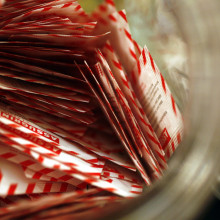
08:51 - Fooling the Brain with Diet Foods
Fooling the Brain with Diet Foods
with Susie Swithers, Purdue University
Ben - If we struggle to change the way that we eat then one solution may be to exchange the foods that we rely on for lower calorie alternatives - using sweeteners instead of sugar or low fat versions that taste almost as good as the full fat original. But could this sort of diet be fooling our brains into thinking that rich, sweet, fatty foods actually don't contain many calories? Professor Susie Swithers of Purdue University believes that this may be the case. Susie, what led you down this avenue of research? Why did you think this might be the case?
Susie - We have lots of evidence that, as Marion talked about, you can learn about the consequences of eating different foods. If that's true , that kind of learning could affect not only preferences as to what you decide to eat, but learning about what the consequences are of eating foods. We know that we typically finish eating long before we could have absorbed or digested all the calories in a meal. So, we're actually making decisions about when to stop eating in anticipation of what's going to happen. We thought that that kind of experience with food, and the caloric consequences of eating foods, could be an important way to determine things like meal size. If that's true, then giving experiences where the taste of food, like a sweet taste, is sometimes followed by a lot of calories and sometimes followed by not very many calories, that could become problematic. Instead of learning that sweet tastes always predicts a lot of calories, what gets learned is sometimes it predicts and sometimes it doesn't predict calories, and that may take away a signal, and that could make things harder.
, that kind of learning could affect not only preferences as to what you decide to eat, but learning about what the consequences are of eating foods. We know that we typically finish eating long before we could have absorbed or digested all the calories in a meal. So, we're actually making decisions about when to stop eating in anticipation of what's going to happen. We thought that that kind of experience with food, and the caloric consequences of eating foods, could be an important way to determine things like meal size. If that's true, then giving experiences where the taste of food, like a sweet taste, is sometimes followed by a lot of calories and sometimes followed by not very many calories, that could become problematic. Instead of learning that sweet tastes always predicts a lot of calories, what gets learned is sometimes it predicts and sometimes it doesn't predict calories, and that may take away a signal, and that could make things harder.
We know that the availability and consumption of foods that are produced with these non-caloric sweeteners has really grown over the last 30 or 40 years at the same time that both the population in the US and now globally, the inability to regulate body weight in the healthy range has increased. So there seemed to be this relationship between the availability and use of these products, and an increase in the inability to regulate body weight. That's what got us interested; could it be the case that these products might actually be interfering with that particular kind of learning?
Ben - How does the body actually count calories? How does it make that link with - I tasted this flavour say, half an hour ago or even an hour ago, and now, I have the following amount of sugar or protein floating around my bloodstream?
Susie - We really don't know the answer to that. There are lots of potential ways that that could happen. There is some evidence in humans for example, using functional imaging data, that the brain can tell the difference between a caloric and a non-caloric sweetener. There's evidence that we have neurons in our brain that are designed to tell us about whether glucose or a particular simple sugar is being utilised. So, that may be one possibility. There are other places in the body that appear to be sensitive to changes in the utilisation or availability of energy - the liver for example. There are also a whole host of hormones that are released in the digestive tract when real sugars actually show up that don't appear to be released when non-caloric sweeteners are involved, and that may be another way we can differentiate between things that deliver calories and those that don't. But we really don't know the answer to what are we tracking.
Ben - So there are obviously lots and lots of different potential mechanisms that we need to look at. What are you actually doing to explore this link?
Susie - What we're doing is re using a simplified model. One of the challenges to answering these questions in humans is that humans have all kinds of experiences with a variety of foods before they show up into a laboratory and it's very difficult to understand and control what sorts of experiences they've had. So we actually use an animal model because we have much better control of what they've been exposed to, and we're trying to use principles that we know about learning in other contexts to understand whether learning is critical and if we can apply principles that we understand from learning to tweak the system and figure out if there are ways to undo any potential negative consequences.
What we typically do is we give our animals experience with diets that are sweet tasting and one group gets a diet that's sweet tasting and that always delivers extra calories. The other group gets diets that are still sweet tasting, but they don't include extra calories. Then we look at the consequences of those diets on things like food intake, body weight, adiposity, how fat they are, and we're also starting now to try to look at whether those kinds of experiences affect hormone release and other sorts of metabolic processes.
Ben - So, the rats who have been exposed to these low-calorie alternatives, when they are then offered a full sugary drink, how did they react? Did they eat or drink just as much as the other rats or do they eat or drink more, and does that then translate into a weight gain?
Susie - If we take animals that have had experience with no-calorie sweetener and then give them access to foods that have lots of calories in them, they overeat as long as those calories are sweet. In fact, if we do this chronically then the animals overeat enough to gain extra weight. We also have some evidence that their energetic or metabolic responses to sweet tasting foods are altered. They don't seem to produce the same increases in body temperature in response to sweet tasting caloric diets. Our interpretation of that is that they've lost the ability to predict that calories are going to arrive and therefore, they seem to be erring on the side of over-consuming and reducing energy expenditure in case energy is not actually delivered.
Ben - So you are seeing both physiological and behavioural responses?
Susie - That's correct.
Ben - Do you think that translates well into people? We know that different species experience flavours in a different way. Are rats particularly good because we think they have the same sort of flavour profile as humans?
Susie - We certainly know that they respond to sweet tastes in a way that's similar in some ways to what humans do. They show strong preferences for sweet tastes and, as Marion pointed out with human infants, infant rats show preferences for sweet tastes from very early in life. So, we believe that that aspect is similar. We also think that this is a very basic learning process. This is the kind of learning that Pavlov started studying almost 100 years ago. It's a fundamental and, we think, really elementary form of learning, and we certainly know that humans can show Pavlovian learning about flavours in a very similar way. Most people are probably familiar with this in the context of not learning pleasant associations with food, but learning unpleasant ones. I've heard stories of people, for example, who've consumed far too much tequila on one occasion, felt ill afterwards and avoid tequila for a very long time. That's a similar sort of process. They've learned that tequila produces a negative consequence and they avoid it. So we think that these kinds of processes are likely to happen in people, but of course, it's a much more difficult question to ask in people.
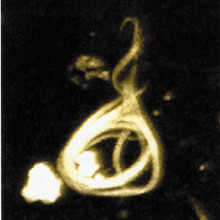
17:16 - Untangling how Alzheimer's spreads through the brain
Untangling how Alzheimer's spreads through the brain
Scientists at Columbia University in New York have figured out how one of the key proteins involved in Alzheimer's disease spreads through the brain.
Alzheimer's disease is a degenerative condition of the brain, caused when specific proteins in the nerve cells, known as beta amyloid and tau proteins, stop performing their proper roles in the nerve cells and instead clump into beta amyloid plaques or tau protein tangles. The tangles formed by the tau proteins were what the researchers at Columbia focussed on.
Post-mortem studies of human patients with Alzheimer's disease had suggested that an area of the brain just behind the ears, known as the entorhinal cortex, might be the starting point for the tauopathy - the degeneration caused by the abnormal tau proteins tangling up. So the researchers set out to engineer mice that would produce the abnormal human tau proteins in their entorhinal cortex, so that they could follow the progress of the disease.
They stained sections of the brains of these mice at different ages to look at where the tau proteins were, and whether they were normal or abnormal. And their results backed up the autopsy studies done in humans - it does appear that the tau proteins spread out from the entorhinal cortex, rather than it being a case of abnormal tau developing independently in separate parts of the brain.
One of the authors of the study, Karen Duff, believes there are several take home messages from their study, published in PLoS One, one of which is that we now have a reliable mouse model that can be used to study the disease further. Another is the rather unusual discovery about the movement of the tau proteins themselves...
'By the way that we looked at these mice we were able to say the tau had left one cell and moved to another cell and that's a radical piece of biology. It's suggestive of prion diseases like mad cow disease where you get a transmission of this abnormal protein through the brain.'
And when this abnormal tau spreads through the brain, it stimulates perfectly normal tau proteins in other cells to switch to being abnormal and start to tangle up. Karen was keen to stress that although these proteins move through the brain in this way, Alzheimer's isn't 'catching' - you can't 'catch' it from someone else.
And although Karen doesn't know exactly how the tangles move through the brain, the final take home message of the study was that it could point the way towards new therapies...
'At the earliest sages of Alzheimer's when the tangles are centred in the entorhinal cortex, when tau is seen there, patients tend not to be demented. So the idea is that if we can identify the disease at that stage and start giving some therapies, we might be able to trap the disease at that stage and stop people fom becoming demented. There are a couple of approaches, but the most targeted approach would be immunotherapy, where you use antibodies to latch onto the specific protein you want to remove and it removes it by a cellular clearance mechanism. You can develop those antibodies to the abnormal tau and perhaps catch the tau as it's outside the cell in the extracellular space.'
And the use of the immunotherapy that Karen mentioned is already being tested, so it represents a positive step forward towards treating Alzheimer's.

21:06 - Super Microscope Watches Living Brain Cells
Super Microscope Watches Living Brain Cells
A clever "superresolution" microscope has allowed researchers to observe changes in a single neuron in the brain of a live mouse. The exceptional level of detail even showed protrusions called dendritic spines moving and changing shape.
The best way to learn about cells is to observe them in context in a living animal. To do so obviously requires a high resolution microscope, but even the best optical microscopes cannot discern features smaller than around 200-300 nanometres, half the wavelength of visible light. To go further and see smaller features involves using an electron microscope, for which the materials need to be prepared by freezing, staining or coating, so cannot be used with living tissue in vivo.
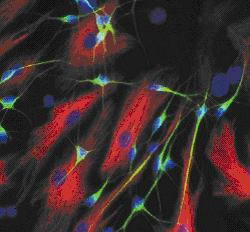 Sebastian Berning and colleagues at the Max Plank Institute for Biophysical Chemistry got around this optical limit by developing a type of Stimulated Emission Depletion, or STED microscopy. This relies on the cells containing a fluorescent dye that can be excited by absorbing certain frequencies of light, but also "de-excited" using other frequencies. By using lasers of different frequencies and varying the intensity across a sample, STEM microscopes are able to only excite a tiny portion of the field of view, effectively increasing the sensitivity from a minimum of 200nm down to less than 70nm across.
Sebastian Berning and colleagues at the Max Plank Institute for Biophysical Chemistry got around this optical limit by developing a type of Stimulated Emission Depletion, or STED microscopy. This relies on the cells containing a fluorescent dye that can be excited by absorbing certain frequencies of light, but also "de-excited" using other frequencies. By using lasers of different frequencies and varying the intensity across a sample, STEM microscopes are able to only excite a tiny portion of the field of view, effectively increasing the sensitivity from a minimum of 200nm down to less than 70nm across.
Berning and colleagues then pointed their STEM microscope at the brains of mice genetically engineered to express Enhanced Yellow Fluorescent Protein (EYFP) in their neurons. Employing a glass window in the skull, they were able to observe live, healthy neurons in situ. By taking images every few minutes, they were able to see dendritic spines moving and changing shape. As these are small processes that stick out of neurons, and are involved in receiving signals from other cells, understanding these could help us to get to grips with how the brain grows and develops, as well as changes over time.
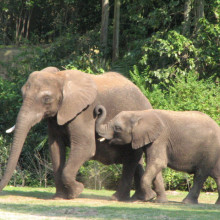
23:40 - Elephants in the Outback
Elephants in the Outback
with David Bowman, University of Tasmania
Sarah - Since humans first set foot in Australia, 50,000 years ago, we've pretty much spelled disaster for the continent. The first settlers wiped out the continent's megafauna, including species of giant kangaroo, and the early English colonists introduced foxes, cats, camels, rodents, rabbits, and even poisonous cane toads, and rampant African grasses - all of which had a devastating effect on the ecology of the country and have driven many of the native species to extinction. So, when an Australian Professor of ecology published a paper suggesting that the answer might actually be to accept that we're never going to return Australia to how it once was and to introduce even more non-native species including elephants to at least stabilise the status quo, it was bound to be controversial. Chris Smith spoke to the author of that paper, the University of Tasmania's David Bowman...
 David - I've recently published a paper in Nature which is a very controversial opinion piece about the environmental management challenges in Australia associated with uncontrolled fires, feral animals, and how they've interacted with the unusual biogeography of the Australian continent. We've sort of started a cake mix - we're mixing up all of these ingredients, now do we try to actually make this cake rise and work as a cake or do we just leave it as some sort of weird slurry? Because all of the introductions which have been made and the changes to fire regimes have all been effectively accidental. So, we already have a very mixed up ecology and the possibility of returning our ecology to anything like Captain Cook would have seen is an impossible dream given the record extinction rates which have occurred in Australia.
David - I've recently published a paper in Nature which is a very controversial opinion piece about the environmental management challenges in Australia associated with uncontrolled fires, feral animals, and how they've interacted with the unusual biogeography of the Australian continent. We've sort of started a cake mix - we're mixing up all of these ingredients, now do we try to actually make this cake rise and work as a cake or do we just leave it as some sort of weird slurry? Because all of the introductions which have been made and the changes to fire regimes have all been effectively accidental. So, we already have a very mixed up ecology and the possibility of returning our ecology to anything like Captain Cook would have seen is an impossible dream given the record extinction rates which have occurred in Australia.
We're in a real predicament and I think that the lesson is that humans have to manage nature, we're in the Anthropocene. We can't just assume that natural systems are going to be self-righting if we've really hammered the natural systems with quite dramatic stresses and introductions. It's very controversial thinking, but I've been living with these problems for 30 years and it was about time somebody said something.
Chris - So what you would argue is that in the past, these introductions and these things have been either mistakes or ill-conceived. But actually, if we use our brains now and start making changes which are based on science and clear evidence, then we could actually work with the problem we've got to help to resolve it and arrive at a better outcome than if we just let things go and try and conserve the status quo, because the status quo is an unstable one.
 David - I think that's the key point. We've moved on and obviously as ecologists, we have much greater understanding of the need for stabilising food webs and the impact of trophic cascades - when you disrupt food chains and how that can actually result in dramatic landscape scale changes. All of this thinking is really ripe to trialling things because what we should be striving to do in Australia is forget about the extermination paradigm and "return Australia to its 1788 Captain Cook status", and more to manage impacts and reduce the impacts of these "threatening processes". Through that, with that human engagement and possibly using some animals as ecological machines to achieve certain outcomes, we can basically steer or stabilise our systems way better than if we just let nature take its course.
David - I think that's the key point. We've moved on and obviously as ecologists, we have much greater understanding of the need for stabilising food webs and the impact of trophic cascades - when you disrupt food chains and how that can actually result in dramatic landscape scale changes. All of this thinking is really ripe to trialling things because what we should be striving to do in Australia is forget about the extermination paradigm and "return Australia to its 1788 Captain Cook status", and more to manage impacts and reduce the impacts of these "threatening processes". Through that, with that human engagement and possibly using some animals as ecological machines to achieve certain outcomes, we can basically steer or stabilise our systems way better than if we just let nature take its course.
Chris - How has this gone down with the Australian public? If you talk to people in Australia, they have been very heavily educated about the impact that introductions and feral animals have had on Australian ecology and for an Australian ecologist to then turn around and say, "We need actually to do this more," they must have quite a strong reaction to that, don't they?
David - Yeah, it's very interesting. Amongst my colleagues, I've been very pleasantly and warmly surprised by the "elephants, a crazy idea but wow! Isn't it great?" response. The people are putting all of the options on the table and stiring up this debate, so a lot of support. Amongst the media, it's a little bit polarised between people just treating it as an absurd joke, who laugh or others who say "yeah, that's a big idea - how do we control some things which are uncontrolled if our plan A approaches aren't working?" Because we're about to run into these problems and I think that the way to advance this is that you have lots of debates and some trials so we can start being a lot more adaptive. We haven't even talked about climate change which is another layer on top of this horrible complex mess we're in.
Chris - So how would you do this in a safe way so we don't see the cane toad problem all over again?
David - Right. Well one thing which is really important to bear in mind is that there's a global dimension. I got a fascinating email from a game manager in Namibia pointing out that when you project at the hundred to a thousand-year perspective on Africa, it's very difficult to see a future for a lot of animals. Just the sheer environmental changes driven by people pressure. Here, we've got a low population density in Australia, we could have game parks. A lot of Australians think that's repugnant, but a cattle farm is okay. But how would we do it? Of course, we'd have to trial things and we'd have to invest money. I would like to see somebody work through the calculation of saying, "Well let's look at all of the available options and a few crazy options to control this out-of-control grass. Let's look at it all and let's cost them with the knowledge we've got available and start a genuine engagement". At the moment, all that's happening is that people are saying, "This is a very bad weed" but in a holistic sense, nobody is doing anything. I would call that an out of control situation and you know, I'm certain that there are solutions to stabilise this, but I'm not quite certain how to do it.

30:41 - On a Diet? Dine with Slow Eaters…
On a Diet? Dine with Slow Eaters…
Our eating behaviour changes to match that of the company we keep due to a subconscious mimicry response that causes us to match our dining partners bite for bite.
It's been known for a while that the company we keep can influence our behaviour at the dinner table. People eat more when others eat more, and less when others limit their intake. Now researchers in Canada and the Netherlands think a subconscious process known as behavioural mimicry might be the reason.
Writing in the journal PLoS One, Roel Hermans from Radboud University Nijmegen in the Netherlands disguised his lab as a restaurant and set up a hidden camera to observe eating habits. 70 pairs of young women, who had not met before the study, were then invited to share a brief dinner, lasting around 20 minutes.
The researchers then counted every single bite that the women took - 3,888 in total - and recorded when they took place in order to determine how many were "mimicked bites" compared with "non-mimicked bites". A mimicked bite was defined as one that takes place within 5 seconds of the other diner taking a bite.
Their volunteers were significantly more likely to take a "mimicked bite" than to take a bite outside that 5 second window - suggesting mimicry was playing a major role in the decision to take each bite.
Previous studies in behavioural mimicry have put forward a possible brain basis for this behaviour; perceiving an action influences the activation of a group of nerves known as mirror neurons - in this case in the motor system that would control the motions required to take a bite - and this makes the perceiver more likely to mimic the action. It's also possible in this particular case that the diners subconsciously monitored each other's actions in order to maintain a similar eating pattern.
As the meal went on, however, the amount of mimicry reduced. The researchers split the 20 minute dining session into two blocks of ten, and found that the women were more than three times more likely to mimic in the first half than in the second. As the women were strangers when they arrived, the researchers attribute this to a getting-to-know-you period, where mimicry is enhanced.
Understanding the behaviours that influence our food intake can help people to take more control over their diet, and be more mindful of the factors that alter how much we chose to eat. But this research can also help to find ways to curb the social influence on more damaging behaviours such as smoking and drinking alcohol.

33:33 - Eavesdropping with Electrodes, Predicting an Eruption and muscle repair with a massage!
Eavesdropping with Electrodes, Predicting an Eruption and muscle repair with a massage!
with Brian Pasley, University of California, Berkeley; Tim Druitt, Blaise Pascal University; Sarah Maddocks, University of Cardiff; Mark Tornopolsky, McMaster University
Eavesdropping with Electrodes
The conversations we hear, and even the ones we have in our own head, have been
decoded by scientists at the University of California, Berkeley.
Activity in an auditory region of the brain called the superior temporal gyrus was recorded by implanting grids of more than 30 electrodes in 15 volunteers as they listened to various words and sentences. The researchers, led by Brian Pasley, could then use the observed patterns of brain activity to predict what the volunteers had heard...
Brian - Different brain sites were representing different frequencies and we could use that understanding of the relationship between the sound frequencies and the brain activity to try to predict what the sound was that the person was listening to. One potential application is, is this perception process similar to internally verbalising or imagining speech? Could it be applied to development of different neuroprosthetic devices for communication for example in patients who are severely disabled or have severe paralysis that have no other means of communication?
---Predicting Eruptions of Calderas
Caldera eruptions could be predicted many years in advance by regularly
monitoring the composition of magma found below.
Calderas are one of the  largest types of volcano known. They can remain dormant for hundreds of thousands of years but have the potential to become active, releasing so much magma in the process that the surface of the Earth caves in.
largest types of volcano known. They can remain dormant for hundreds of thousands of years but have the potential to become active, releasing so much magma in the process that the surface of the Earth caves in.
Analysing samples of pumice from Santorini in Greece, providing records of magma activity in the build up to Santorini's eruption in the late 1600's, Tim Druitt from Blaise Pascal University discovered the presence of rock crystals that only form in the decades leading up to an eruption...
Tim - There was this long period of dormancy before, many thousands of years, and yet suddenly, something happens to form all these crystals. The processes that were priming this volcano for this big eruption actually occurred in a very short time scale, and it really would be sensible to monitor these better to improve our chances of picking up the re-awakening of these systems.
---The Sweet way to keep bacteria at Bay
Honey could hold the key to keeping wound infections at bay.
Wound infections can often be hard to treat because bacteria form a defensive barrier known as a biofilm, which can impede the ability of antibiotics to access the affected area.
Now a team at the
University of Cardiff led by Sarah Maddockshave shown, in a culture dish, that medical-grade manuka honey can dismantle these biofilms, making wounds caused by common bacteria like streptococcus pyogenes easier to treat...
Sarah - If you apply honey whilst your growing the biofilms, you get a statistically significant reduction in the amount of biofilm that grows which suggests that it would be a useful prophylactic treatment. But we also found that if we grew the biofilms to 24 hours and then treated them for 2 hours with the manuka honey, we could get a total reduction in the biofilm biomass of about 85%.
---Massaging your Aches and Pains Away
And finally, a massage could speed up muscle repair and recovery after injury.
Whilst massages have long been used in physical rehabilitation, the mechanisms behind their beneficial effects were unknown.
Now, performing massage therapy on male volunteers after heavy exercise and analysing muscle biopsies, Mark Tornopolsky and colleagues from McMaster University found that just 10 minutes of massage resulted in reduced inflammation and increased production of structures called mitochondria which give cells energy...
Mark - It certainly is very encouraging that we can reduce inflammation which might help someone to recover faster and get on to their next training bout and we know from many studies that endurance exercise and having greater mitochondrial capacity is a good thing and can reduce the incidence of diabetes, obesity, and improve muscle function in older adults. So I think anything that enhances mitochondrial function is likely to have significant clinical benefits.
And this work was published this week in the journal
Science Translational Medicine.

38:05 - The Conservation Hotlist - Planet Earth Online
The Conservation Hotlist - Planet Earth Online
with Bill Sutherland, University of Cambridge
A new study into the top conservation issues facing the World gives an insight into the environmental problems we may be reporting on in the coming years. Compiled by an international team of experts, its concerns include: mining in the deep sea for rare Earth elements and invasive species in Antarctic waters, as well as new technologies including the rapid development of graphene. Planet Earth Podcast presenter Richard Hollingham went went to the University of Cambridge to speak to the leader of the research, Bill Sutherland...
Bill - We see our role as identifying issues that we think warrant greater research and then feeding that research into the policy process, so that policy makers can be more informed and make better decisions when they need to do so.
Richard - Let's look at the list here which I've got in front of me. I won't run through all 15 issues but there's certainly a key theme with the first four. All marine conversation - you talk about warming of the deep sea, mining in the deep ocean, methane venting from the ocean floor and climate driven colonisations in Antarctic waters, by which you mean invasive species moving into these pristine Antarctic territories.
Bill - Absolutely, and I noticed that theme too. I think partly it's because there are some serious marine problems but also the technology is improving so we're learning a lot more about marine habitats and we're beginning to identify some of the serious up and coming threats.
there are some serious marine problems but also the technology is improving so we're learning a lot more about marine habitats and we're beginning to identify some of the serious up and coming threats.
Richard - One of the other issues I was quite taken with on this list was graphene. This year, the UK government has put £50M into graphene research, there have been Nobel Prize winners for graphene research. It's seen as the next big technological thing.
Bill - Absolutely. And nanotechnology is clearly an enormous area and there are lots of exciting possibilities including lots of exciting environmental possibilities, including graphene. As a material, it has all sorts of exciting properties that can be of great benefit. What we do is we say that we really want to then look at what the consequences of that might be and just make sure that there aren't any unforeseen environmental consequences, bearing in mind there's likely to be such a huge change with the development of nanotechnology.
Richard - Is that what a lot of this is about? Seeing a new technology and saying what are the implications of that for the environment?
Bill - Very often and I think often as environmental scientists, we've not been very good at that. I think for the GM debate we didn't actually have the science in place when the major decisions had to be made, so we want to look ahead and make sure we've got the science in place for new technologies, and for other issues as well, so that we can foresee what the debate might be and make sure the debate is better informed.
Richard - The other one on the list - I didn't even know what these were - are nuclear batteries. What is a nuclear battery and why are you worried about it?
Bill - Nuclear batteries are a new way of generating energy. You can do it very much on a small scale and that means that you can then have energy sources in new areas and that adds benefits for environmental monitoring. It also means you can create development in areas that would otherwise be impossible. And we're interested in identifying any major environmental disruption, any environmental change that might change the way the world looks and it was thought that that might be one of these sorts of features.
Richard - I suppose just off the top of my head the obvious problem with a nuclear battery is what happens when someone throws it away.
Bill - Absolutely, that is a major problem and they are much less polluting than nuclear power stations but obviously they have serious issues related to the waste. They also, by providing easy sources of energy if they are widely developed, will result probably in different patterns of development and we're interested in then predicting what the consequences of those might be.
Richard - Just a few metres away from your office is the Zoological Museum here in Cambridge and it's quite sobering walking around to see the number of extinct birds on display, along with fossils- there's a giant sloth. Is that something that keeps you going, saying we don't want another one of those?
Bill - Absolutely. We're committed in Cambridge to developing conservation and making conservation more related to policymakers with the hope that we can then reduce the likelihood of future extinctions. That's clearly extremely important and we're deeply committed to it.
Richard - This is the third year you've done it, can you look back and say, well we identified that or can you look at any successes?
Bill - The one we like the most, but I think is probably a complete coincidence, is in the first one we did we identified the issue of high latitude volcanism and particularly what would happen if Icelandic volcanoes went off. Then, a couple of months later, that happened! I've been accused of trying to set it off, I think that's just fortuitous. But a number of the other issues have very much come up the agenda since. So fracking, we identified fracking in our meeting two years ago - the issue of generating gas by pumping water into rocks. That's now a major environmental concern.
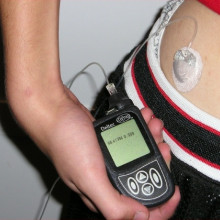
44:46 - New Ways to Monitor Diabetes
New Ways to Monitor Diabetes
with Charles Rennie, University of Bristol
Ben - One of the well-known consequences of being overweight, especially for a long time, is an increased risk of developing diabetes. This leaves patients unable to control their own blood glucose level and causes serious complications including kidney failure and loss of sight. Synthetic chemists like Bristol University's Charlie Rennie are leading the charge to find useful new molecules...
Charles - The World Health Organisation has estimated that 346 million people worldwide are currently suffering from diabetes, so there's a massive demand for bringing new medicines, new treatments to market to help these people. So, one of the main focuses of our research at the moment is, can we find a way in which we can offer continuous glucose monitoring. So a way of continuously monitoring sugar levels within diabetic patients.
Ben - At the moment, diabetics tend to monitor their own blood glucose level by a very old method of pricking their finger and sampling the blood. What's wrong with that technique?
Charles - One of the main problems is that it relies on the patient themselves having to determine when they should measure their glucose levels. They may forget at one point, or they may be busy and or not do it at the necessary time and therefore, they don't have an accurate reading of what their sugar levels are all the time. This can have quite serious effects. It can obviously lead to having quite high glucose levels when they feel that they don't have.
Ben - So, they only monitor their blood glucose level when they remember, they then take an appropriate amount of insulin. That might mean that they  are overmedicating themselves or medicating too often, or in fact, not medicating enough. So what we need is a method where we have a constant idea of how much medication you need and we always give exactly the right amount of medication?
are overmedicating themselves or medicating too often, or in fact, not medicating enough. So what we need is a method where we have a constant idea of how much medication you need and we always give exactly the right amount of medication?
Charles - Yeah, I feel that that's obviously the goal and where we'd like to be with the treatment of diabetes. Currently, there are systems which do offer continuous glucose monitoring. However, there's quite a few problems with these current systems. Many of them are enzyme based and therefore have quite a limited lifetime. They normally have a lifetime of up to about 3 days, so they can be implanted then have to be removed after 3 days. Therefore, this has obviously not taken widespread use, as it's quite an awkward thing for the patient in order to have this implanted and then removed.
They also tend to measure sugar levels from interstitial fluid, which is the fluid which surrounds cells in the body, and therefore, they're not in direct contact with the bloodstream. There seems to be a lag between the actual glucose levels in the blood and the readout you normally get from these devices. So, obviously there are still quite a few improvements that can be achieved in this and this is probably where our research comes in. We have looked at making ways in which continuous glucose monitors can be used 24/7 for prolonged periods of time and offer a really accurate readout of glucose levels for diabetic patients and therefore improve the treatment and management of the disease.
Ben - There are obviously lots of challenges in getting that right. What's the approach that you're taking?
Charles - The approach we're taking at the moment is; can we really focus on trying to bind glucose initially? Can we find a system which selectively binds glucose from an aqueous media such as water? Therefore, we're looking to take it right back and design molecules initially based on molecular modelling, matching up the different parts of the sugar molecule to a receptor in a cage structure around that, and then using chemical synthesis to put this molecule together, in order to give a highly selective molecule for binding sugars. Also, we'd like a compound which would give an output upon binding, such as a change in optical properties, or a changing voltage or something which we then could relate back to say, how much sugar was bound at any particular moment.
Ben - So you're looking at the molecular structure, both of the glucose - the thing you want to bind - and then of candidate molecules that would lock very tightly to that glucose and then give you some kind of readout. So what are the sorts of candidates you're looking at?
Charles - The kind of candidates we're looking at are quite rigid structures and we want them to be positioned quite neatly and compactly around the sugar molecule. Candidate molecules also have to have a certain amount of water solubility, so they have to have groups on them which will make them go into water. This as the medium which we want to operate in. We also want them to have the best matchup to the functionality on the glucose, on the sugar molecule. So we're giving them dual characteristics, so there are dual properties in which certain parts of the molecules will entrap certain parts of the sugar molecule and then other parts will entrap the other parts of the sugar molecule to give a more closely knit binding.
Ben - And how's it going so far? Do you have a range of molecules that you're currently testing?
Charles - Currently, we've managed to synthesise a couple of molecules which offer selective glucose binding from an aqueous medium. They seem to be stable in blood plasma. So currently, we have quite a good starting point. However, there's a few problems surrounding some of these. The synthesis of these molecules is long winded, with quite a lot of steps so obviously, it's going to cost a lot of money in the long term, and obviously takes a lot of time. We'd like to reduce the number of steps in order to make these compounds.
Also, the changing properties, which I eluded to earlier, don't seem to be as strong and clear-cut as we would quite like at the moment, so we'd like a more distinct change upon binding of the sugar. Therefore, there's quite a bit of work surrounding the tuning of these properties in order to get a better readout of how much sugar will be bound.
Ben - If this is something where the ultimate aim is to put it inside somebody, we also need to be very careful that it isn't going to react to biological tissue and of course, is not going to provoke an immune response.
Charles - Yes. Initially, we'd just like to find a system which will bind sugar. But in the long term, if we do find a system which seems to be adequate in doing this, then we then do a full range of screens and tests on these compounds in order to determine their biological activity, stability and toxicity.
We'll also look to consider how it would be best to administer this kind of compound into the body. Would it be best to have it localised in a certain place, as an implant, or would it best to inject it into the system? We're thinking at the moment that an implant would be the best situation as we can implant in direct contact with the blood flow, hopefully, in order to get an accurate readout of glucose levels, but also to prevent the compound from moving around the body and interfering with other areas.
Ben - Once you have found your perfect compound that's biologically compatible, it locks in very specifically to glucose, and then gives you a very distinct change in properties, what do you then see us doing with that readout?
Charles - Ideally, we'd like a system which the change in properties were to be able to be detected externally by wearing something such as a watch. Then you could get a readout on the watch of your glucose levels, at any point you want. You could have an alarm system which tells you when it's going high. But also, we envision connecting our system up to something which currently exists, such as an insulin pump, which will then inject appropriate amounts of insulin into the patient. Then we have set up a system almost like an artificial pancreas, and that would be a very strong way of treating diabetes and managing the current disease.
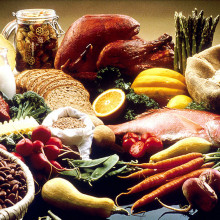
Do our cravings reflect a lack of certain nutrients in the body?
Susie - There is certainly some evidence if you induce a state of significant deficit that animals will show preferences for foods that contain those, but in terms of in a relatively healthy population, whether we actually show specific cravings for nutrients, that's a much tougher question to find evidence for.
Ben - Marion, if I could bring you into this, thinking about the foods that people crave. There must be some sort of developmental link in that that we crave things that we are familiar with and not necessarily nutrition that we need, but food that we like?
Marion - Well certainly, the evidence from psychology suggest that food cravings are very common and they're very rarely, as Susie says, associated with a particular deficit. Lots of research has shown that food cravings are common in men and women and they tend to be for foods that are very popular like chocolate and confectionery although men tend to crave things that are salty and savoury. So, yes, cravings are to do with familiarity and what you've learned to like under certain circumstances.
Certainly, in dieters, it seems that cravings can be stronger for foods that people are trying to avoid. As a psychologist, I'm very interested in food cravings because they quite often point to foods that are desirable because we're meant to limit them, because they're tempting, and because we're trying to restrict them when we're dieting.
So, chocolate, for example, is a very commonly craved food and it's not about any kind of nutrient deficiency, and this is really nicely demonstrated by a data from Paul Rozon who gave people who crave chocolate a box and he said, "Whatever is in the box, have this when you're craving chocolate."
The box was either empty or it had capsules containing cocoa powder or white chocolate or milk chocolate. White chocolate remember has no sort of cocoa. It has just cocoa butter. It doesn't have any bioactive ingredients. And what they found was that cravings could be reduced in chocolate cravers by white chocolate and by milk chocolate.
So it wasn't that the cravings were really directed towards any kind of nutrient or any kind of physiological deficit, but rather because of the comfort of eating something that was really delicious - melt in the mouth, sugar and fat, absolutely delicious.
That's where cravings come from...

55:00 - How much of me is the original me?
How much of me is the original me?
We posed this question to Kirsty Spalding, regeneration expert at the Karolinska Institute in Sweden...
Kirsty - For starters in the brain, most of your nerve cells that you're born with will be the ones that you have when you're older. Although we do continue to lose nerve cells as we age, there's very little areas in the brain that actually make new nerve cells in adulthood.
Also the lens capsule in the eye, this is also not turning over at all so the lens capsule will be as old as you are.
And with teeth, once we have our mature teeth, the enamel that's laid down in these teeth, this is not turned over at all.
Other organs in the body have much more dynamic turnover. An example of this is fat. We replace 50% of our fat cells per year. Other tissues, such as muscle, by the end of a relatively healthy lifespan of about 75 years, less than half of the muscle cells in the heart will have turned over.
Bone is a rather complex structure and in the middle, it has the bone marrow which is making the white and the red blood cells. Here, this is a highly proliferative area, such that millions of cells are being born per second. So as you can see, there's quite a range in contrast of turnover rates of all the different cell types in the body. And with regards to your question on what happens to the shed tissue, sometimes our cells are broken down into their components and recycled or if they're toxic, they can be packaged up for removal of a further processing, or they can be used up in the form of energy.










Comments
Add a comment